Aberrations in Mitosis and Cellular Composition
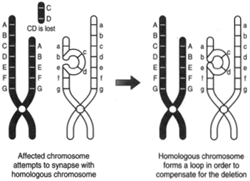 |
Fig. 3-10 Consequently, when the chromosome with the deletion seeks to synapse with a normal chromosome, a portion of the normal chromosome has nothing with which too pair and is as a loop. |
Aberrations in mitosis can be induced by altering the environment. Alternating hot and cold as well as treatment with certain chemicals such as mustard gas, naphthalene acetic acida, nd colchicine can cause changes in mitosis. The normal events at anaphase result in chromatids separatinagn d moving to opposite poles. However, a process called nondisjunction can occur. In nondisjunction, both members of a pair go to the same daughter cell. This results in aneuploidy: one daughter cell wil have 2N + 1 chromosomes, and theo ther daughterc ell will have 2N − 1 chromosomes. This kind of aberration can occur in meiosis as well.
Some families of plants have species that naturally differ in the number of chromosome sets per cell nucleus. As mentioned earlier, this cellular condition is called polyploidy. A certain rose, for instance, has races or varieties having N, 2N, 3N, 4N and on to 16N. A similar situation occurs in wheat, where the basic number is 7N. The wheat used for making flour is 6N (6 × 7 = 42 chromosomes). The cells of roots are frequently polyploid. In corn (Zea mays), most of the cells of the root have two to four times as much DNA as do normal diploid cells. Certain cells associated with the conduction of water have been found to be 32N, or 16 times the diploid number.
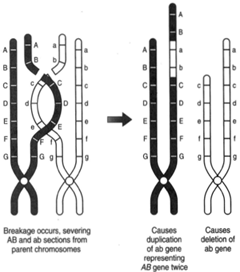 |
| Figure 3-11 A duplication. Genes A and B are represented twice |
Aside from changes in the number of chromosomes, the structure of individual chromosomes can also be altered. Examples of such alterations are deletion, duplication, inversion, and translocation. In deletion, part of the chromosome breaks away and is therefore unable to go through mitosis. The normal pairing of homologous chromosomes produces two parallel strands, but deletion produces another pattern of pairing.
An opposite kind of change happens in duplication. As shown in figure 3-11, the given genes A and B are represented twice. A chromosome may also break and then mend. If it mends in the same place, no alteration occurs: but if a break occurs and the broken part instead inverts before mending, a new sequencing of the genes results. This is inversion (figure 3-12).
Reciprocal translocation is a frequent chromosomal aberration and its occurrence in the Evening Primrose Oenothera has been much studied. At the left side of figure 3-13 are two pairs of chromosomes. One pair has the genes A through H, and the other pair has the genes I through P. A break occurs in one of each of the chromosomal pairs. In mending, the segments trade places. When synapsis takes place, only homologous parts are able to pair. As shown in the figure, the chromosomes can synapse only along half of their lengths, and the interchanged segments cannot synapse normally because they are not homologous. Synapsis is achievable, however, as represented in figure 3-14. Two normal chromosomes position as shown at left in the figure and the altered chromosomes can then synapse as shown at right. When the chromosomes later separate during anaphase, they take thef orm of a circle. In Oenothera biennis (7N) , translocations have taken place in a manner to create a circle of fourteen chromosomes during anaphase.
 |
| Figure 3-11 A duplication. Genes A and B are represented twice |
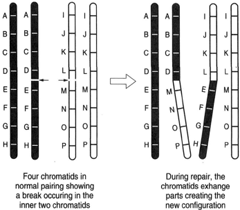 |
| Figure 3-12 An inversion. Genes C, D, and E are reversed |
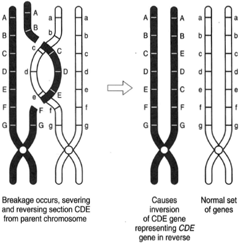 |
| Figure 3-12 An inversion. Genes C, D, and E are reversed |
 |
Figure 3-13 A reciprocal translocation. Four chromatids are represented in a normal
pairing at the left, but a breck occurs in the inner two chromatids. In repairing, they
exchange parts, creating the configuration shown at right. Because only homologous parts
can synapse, the translocated portions cannot synapse with the normal chromatids. |
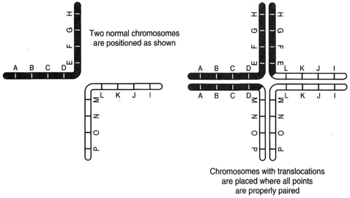 |
| Flgure 3-14 Synapsis of chromosomes where a reciprocal translocation has taken place. Two normal chromosomes are positioned as shown at left. The chromosomes with translocations can then be effectively placed so that all points are properly paired, as shown at right. |
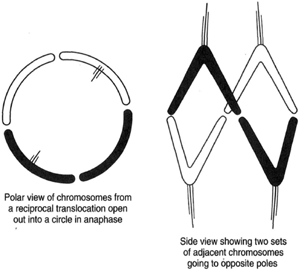 |
| Figure 3-15 When the chromosomes from a reciprocal translocation go into anaphase, they open out into a circle, left. Adjacent chromosomes go to opposite poles, as shown in the side view at right. |




